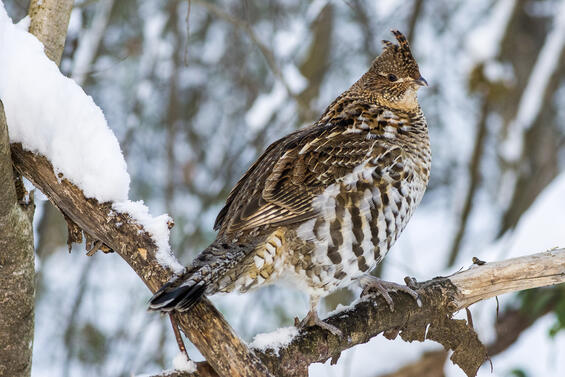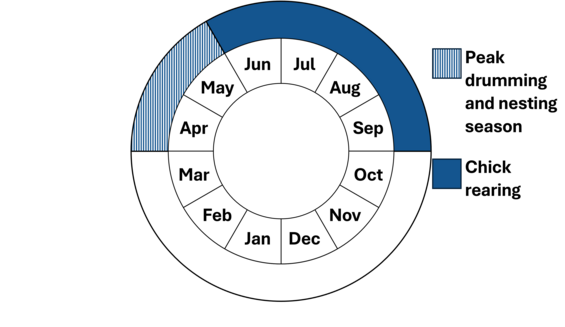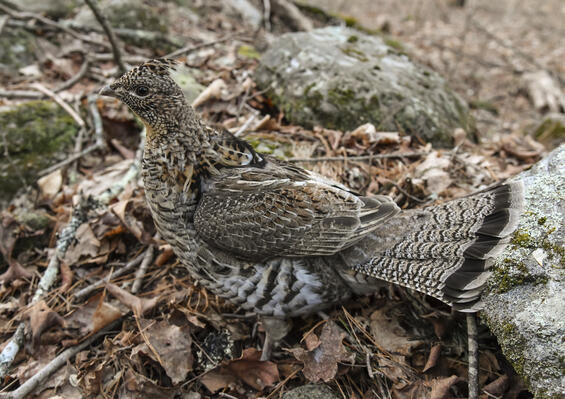- Scientific name: Bonasa umbellus
- Species of Greatest Conservation Need (MA State Wildlife Action Plan)
Description

Ruffed grouse (Bonasa umbellus)
The ruffed grouse is a medium-sized grouse, weighing 450–750 g (16–26 oz). Males are slightly heavier than females. Coloration is cryptic with upperparts that are most commonly mottled rusty-brown with buff and black barring. Red or gray color phases can also occur. Underparts are barred with dark brown and buff fading toward the belly. A narrow buff-colored band runs from the lores to just behind the eye. The head has a long crest of blotchy brownish gray feathers that can be erected and on each side of the neck is a tuft of long black or brownish feathers that can be erected into an umbrella-like ruff. The rounded tail is reddish-brown or gray and has broad pale bands separated by narrow black bands and barring and a prominent dark subterminal band. Females generally have an incomplete subterminal band. The rump feathers of males have two whitish dots. In general, females look similar to males but have a shorter crest and one whitish dot on the tail and rump feathers.
Life cycle and behavior

This graphic represents the peak timing of life events for ruffed grouse in Massachusetts. Variation may occur across individuals and their range.
Grouse have a diverse diet that changes seasonally as different food items become more and or less available. A large part of a ruffed grouse’s winter diet comes from the buds and catkins of aspen, birch, alder, and cherry saplings. Grouse also rely on food from soft mast-producing trees and shrubs like apple, blueberry, grape, high bush cranberry, and hawthorn along with hard mast like acorns, hazelnuts, and beech nuts. Overgrown, brushy fields provide an abundance of protein-rich insects in the summer for developing grouse chicks.
In Massachusetts, ruffed grouse mating season occurs in spring. They are not monogamous, and males may breed with multiple hens. In addition to ruffling their neck feathers and fanning their tails, males will court females by standing on a log or rock and beating their wings against the air to make a drumming sound. Males will also drum to claim their territory. After mating season, hens will make their nest on the ground and lay 8–14 eggs. The eggs will hatch about a month later and the young will stay with the hen until their first fall.
Population status
Grouse are found statewide with the exception of highly populated urban and suburban areas. Grouse populations are associated with areas with predominantly forest cover. Consequently, portions of central and western Massachusetts have the most robust populations. That said, grouse can still be found in eastern areas including Cape Cod, but in limited numbers. Grouse populations have declined substantially since the mid 1950s, however their population numbers have been relatively stable across much of the state since around 2015.
Distribution and abundance
Ruffed grouse are fairly common in wooded areas throughout Massachusetts, but scarcer on Cape Cod and absent from Nantucket and Suffolk Counties. They were introduced to Martha’s Vineyard, Dukes County, in the 1960s but they are likely extirpated from the island. Populations were likely highest between the late 1800s and the mid-1950s when the Massachusetts landscape provided a mix of fields and early successional forest. As the forests of Massachusetts matured and predator populations grew, grouse numbers declined. Grouse numbers can fluctuate substantially from year to year depending on suitability of habitat, brood rearing conditions, and predator populations.
Habitat
Ruffed grouse occupy a variety of different habitats in Massachusetts. They prefer early successional mixed deciduous-coniferous forest but inhabit mature deciduous mixed forest in the western part of the state and scrub oak forest on Cape Cod. Drumming logs are important for male breeding displays. Early successional hardwood forest with high stem densities and good visibility at ground level is important for male drumming sites.
Healthy habitats are vital for supporting native wildlife and plants. Explore habitats and learn about conservation and restoration in Massachusetts.

Threats
Ruffed grouse in Massachusetts and throughout the Northeast have been declining due to loss of suitable habitat to forest succession and development. Large-scale regional management is required to provide a mix of early-seral and mid-seral forests throughout Massachusetts. Weather conditions and food resources affect brood survival and recruitment. Predation is a major cause of mortality and may affect grouse population numbers when recruitment is not optimized. Predation by domestic cats has been identified as the largest source of mortality for wild birds in the United States with the number of estimated mortalities exceeding 2 billion annually. Cats are especially a threat to those species that nest on or near the ground.
An additional threat to the species is collisions with buildings and other structures, as approximately 1 billion birds in the United States are estimated to die annually from building collisions. A high percentage of these collisions occur during the migratory periods when birds fly long distances between their wintering and breeding grounds.
Conservation
Ruffed grouse are surveyed annually through MassWildlife’s annual drumming survey, where biologists count the number of drumming male grouse on road-side survey routes. Thirty-three routes exist statewide that are randomly located in areas with potential suitable habitat (forested portions of the state) and 10 additional routes are surveyed in areas with known high-quality habitat. This survey provides a broad index to ruffed grouse drumming activity across the state but is a bit course for making site specific projections of grouse abundance. Additional monitoring is accomplished via alternative survey efforts such as Christmas Bird Count survey, Breeding Bird Survey, and community-based observation logged through e-Bird. In recent years, the latter is becoming an increasingly useful way to monitor and assess grouse and other less common bird species.
MassWildlife is active in managing a variety of early successional and young forest habitats that are required by ruffed grouse at various times of the year, including young forest and other early successional habitats found in forested areas of the state. MassWildlife collaborates with private landowners to manage habitat through partnerships and programs within the U.S. Department of Agriculture (USDA) Farm Bill. MassWildlife also often consults and promotes early successional and young forest management beneficial to ruffed grouse and numerous other species with other conservation organizations and public landowners across the state.
Bird collision mortalities can be minimized by making glass more visible to birds. This includes using bird-safe glass in new construction and retrofitting existing glass (e.g., screens, window decals) to make it bird-friendly and reducing artificial lighting around buildings (e.g., Lights Out Programs, utilizing down shielding lights) that attract birds during their nocturnal migration. Promote responsible pet ownership that supports wildlife and pet health by keeping cats indoors and encouraging others to follow guidelines found at fishwildlife.org.
Contact
| Date published: | May 1, 2025 |
|---|